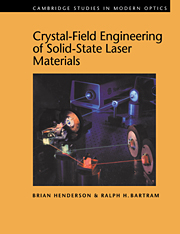Book contents
- Frontmatter
- Contents
- Preface
- 1 An introduction to lasers
- 2 Symmetry considerations
- 3 Optical crystals: their structures, colours and growth
- 4 Energy levels of ions in crystals
- 5 Spectra of ions in crystals
- 6 Radiationless transitions
- 7 Energy transfer and excited state absorption
- 8 Covalency
- 9 Engineering the crystal field
- 10 The crystal field engineered
- References
- Index
1 - An introduction to lasers
Published online by Cambridge University Press: 24 September 2009
- Frontmatter
- Contents
- Preface
- 1 An introduction to lasers
- 2 Symmetry considerations
- 3 Optical crystals: their structures, colours and growth
- 4 Energy levels of ions in crystals
- 5 Spectra of ions in crystals
- 6 Radiationless transitions
- 7 Energy transfer and excited state absorption
- 8 Covalency
- 9 Engineering the crystal field
- 10 The crystal field engineered
- References
- Index
Summary
Historical notes
Laser is an acronym for Light Amplification by Stimulated Emission of Radiation. The operating principles of the laser were originally elucidated for devices operating at microwave frequencies (masers). The maser was invented by Gordon, Zeiger and Townes (1955), who used an inverted population between the excited vibrational levels of ammonia. Extension of the wavelength range of the maser into the optical regime was proposed by Schawlow and Townes (1958), whose various laser schemes all comprised a gain medium, an excitation source to pump atoms or ions in the gain medium into higher energy levels and a mirror feedback system to enable one or multiple passes of the emitted radiation through the laser medium. The special qualities that distinguish laser light from other optical sources include extreme brightness, monochromaticity, coherence and directionality. Also the laser output is linearly polarized and very frequency stable. After development over forty years modern lasers operate over wavelength ranges from the mid-infrared, through the visible and beyond into the ultraviolet and vacuum ultraviolet ranges.
The first operational laser used synthetic rubies, corundum crystals containing ∼0.1 wt.% of Cr2O3, as the gain medium, pumped with white light from a helical flashlamp to oscillate on the sharp R-line at a wavelength of 693.4 nm [Maiman (1960)]. Soon afterwards the He–Ne laser was operated on the 3s → 2p (632.8 nm), 2s → 2p (1.15 μm) and 3s → 3p (3.39 μm) transitions of atomic Ne.
- Type
- Chapter
- Information
- Publisher: Cambridge University PressPrint publication year: 2000



